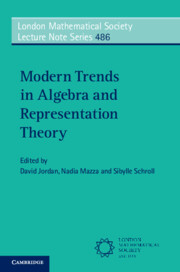Book contents
- Frontmatter
- Contents
- Contributors
- Preface
- Introduction
- 1 Auslander–Reiten Theory of Finite-Dimensional Algebras
- 2 τ-tilting Theory – an Introduction
- 3 From Frieze Patterns to Cluster Categories
- 4 Infinite-dimensional Representations of Algebras
- 5 The Springer Correspondence
- 6 An Introduction to Diagrammatic Soergel Bimodules
- 7 A Companion to Quantum Groups
- 8 Infinite-dimensional Lie Algebras and Their Multivariable Generalizations
- 9 An Introduction to Crowns in Finite Groups
- 10 An Introduction to Totally Disconnected Locally Compact Groups and Their Finiteness Conditions
- 11 Locally Analytic Representations of p-adic Groups
- References
5 - The Springer Correspondence
Published online by Cambridge University Press: 25 November 2023
- Frontmatter
- Contents
- Contributors
- Preface
- Introduction
- 1 Auslander–Reiten Theory of Finite-Dimensional Algebras
- 2 τ-tilting Theory – an Introduction
- 3 From Frieze Patterns to Cluster Categories
- 4 Infinite-dimensional Representations of Algebras
- 5 The Springer Correspondence
- 6 An Introduction to Diagrammatic Soergel Bimodules
- 7 A Companion to Quantum Groups
- 8 Infinite-dimensional Lie Algebras and Their Multivariable Generalizations
- 9 An Introduction to Crowns in Finite Groups
- 10 An Introduction to Totally Disconnected Locally Compact Groups and Their Finiteness Conditions
- 11 Locally Analytic Representations of p-adic Groups
- References
Summary
We present some key concepts and tools in the field of geometric representation theory. We review the background necessary to state the Springer correspondence for an arbitrary semisimple Lie algebra. We then study the notion of convolution in Borel–Moore homology and see how to apply it to the Springer correspondence. Finally, we reframe these ideas in the language of perverse sheaves and intersection homology.
- Type
- Chapter
- Information
- Modern Trends in Algebra and Representation Theory , pp. 169 - 211Publisher: Cambridge University PressPrint publication year: 2023

